Lighting In Art Galleries & Museums: A Comprehensive Guide
Table of Contents
Finally, even if not all the artwork in the gallery is yours, you can still infuse your personality into the space. Your gallery can become an artwork through distinct lighting designs, leaving a memorable impression on every visitor.
Types Of LED Lights For Gallery Illumination
Let’s see the common LED lights you can use for an art gallery–
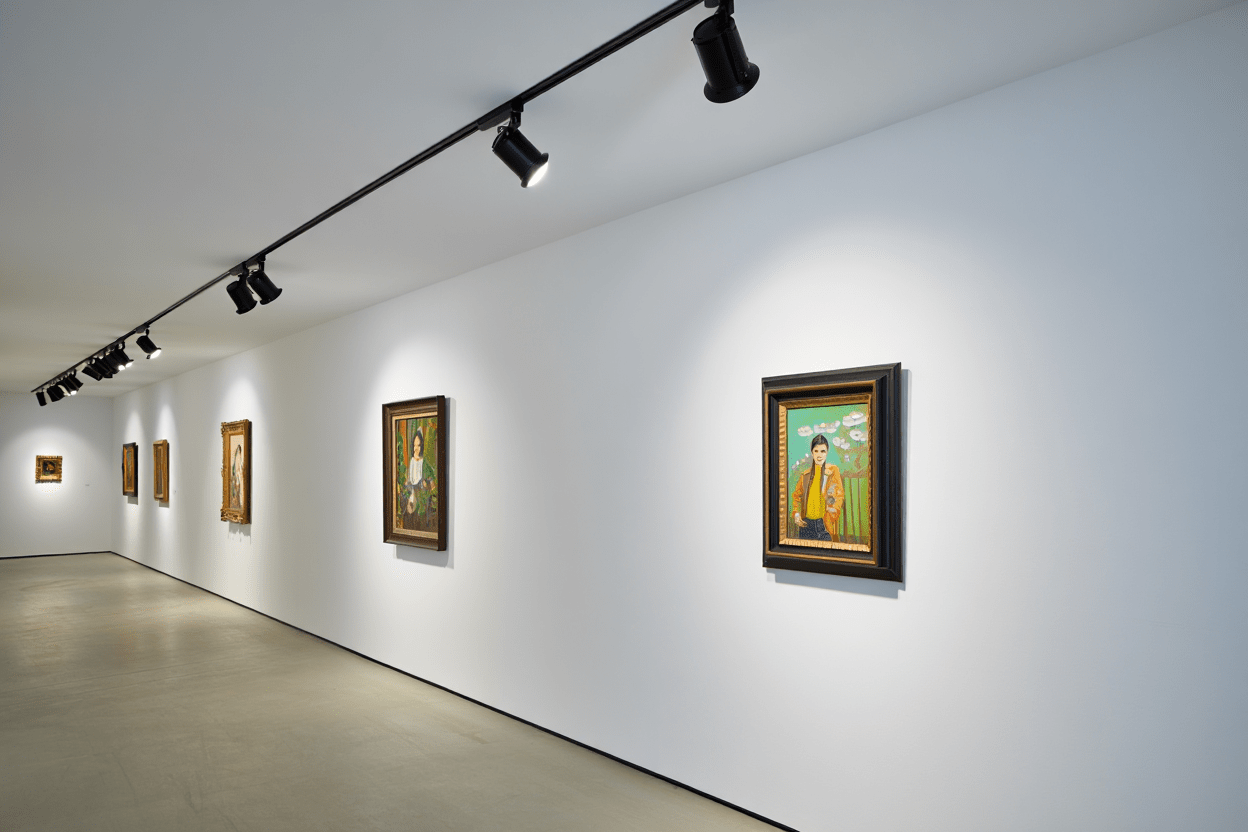
1. Track Lights
Track lights are ideal for those who wish to maintain a clutter-free space. They provide a minimalist design that complements art gallery aesthetics. They also emit a cool color temperature, fostering a warm and inviting atmosphere.
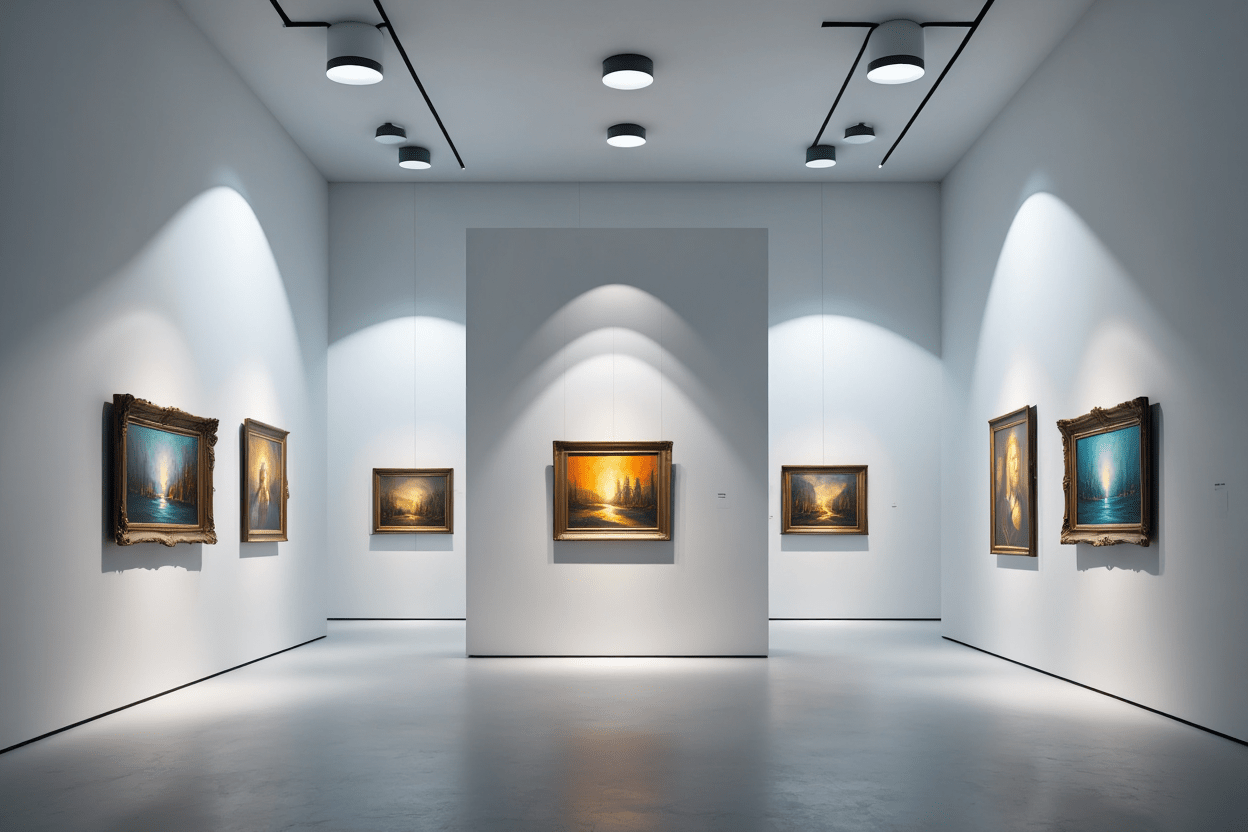
2. Recessed Lights
These lights are another excellent choice for use in art galleries. The recessed lights are fit, neat, and you can hang them on the ceiling. This way, you can make the space look tidier and modern. Besides galleries, they are often used to highlight different types of art. As they are flexible, they can move across and change the angle based on your needs.
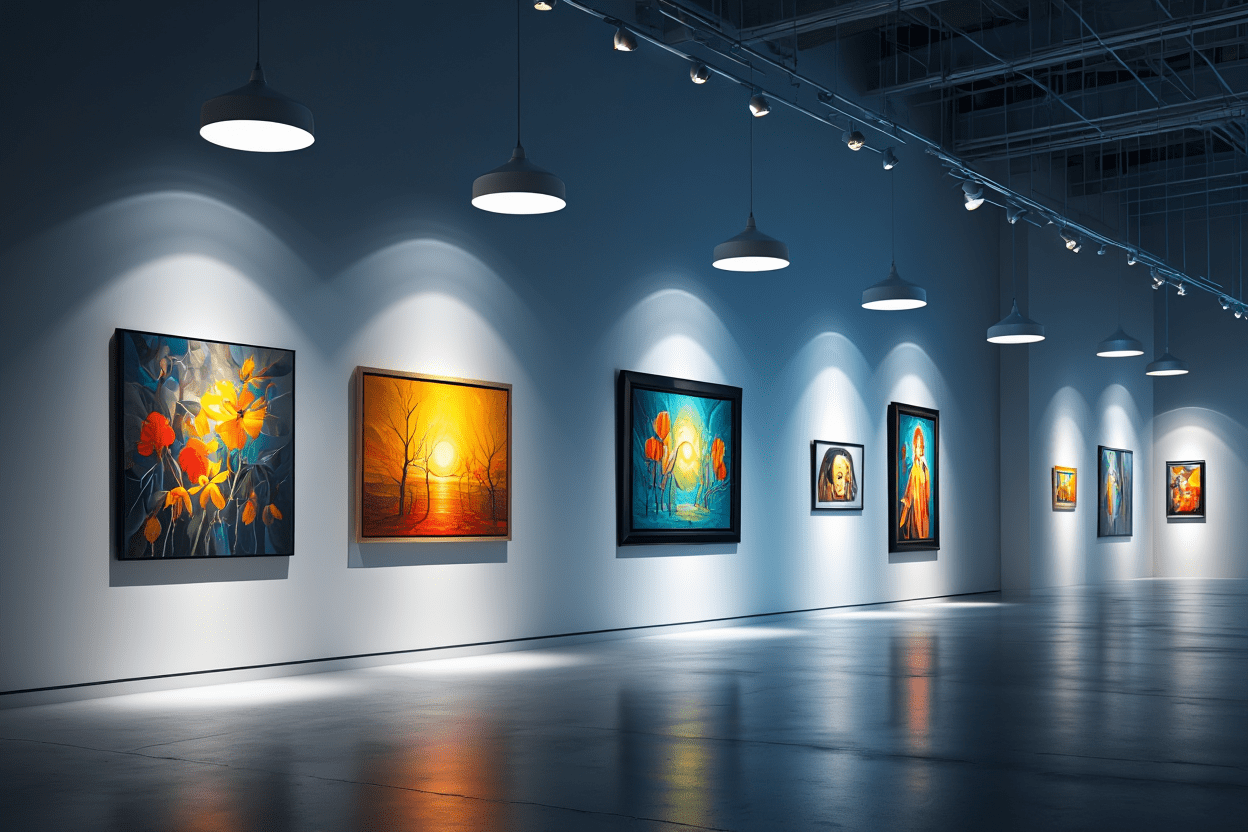
3. Surface-Mounted LED Downlights
These versatile LEDs can be affixed to various surfaces, including walls and ceilings. Their key advantage lies in their non-glare nature, validating the investment in an SMD system. And you can position downlights on the walls opposite the artwork; they eliminate the issue of reflections or glare on the displays.
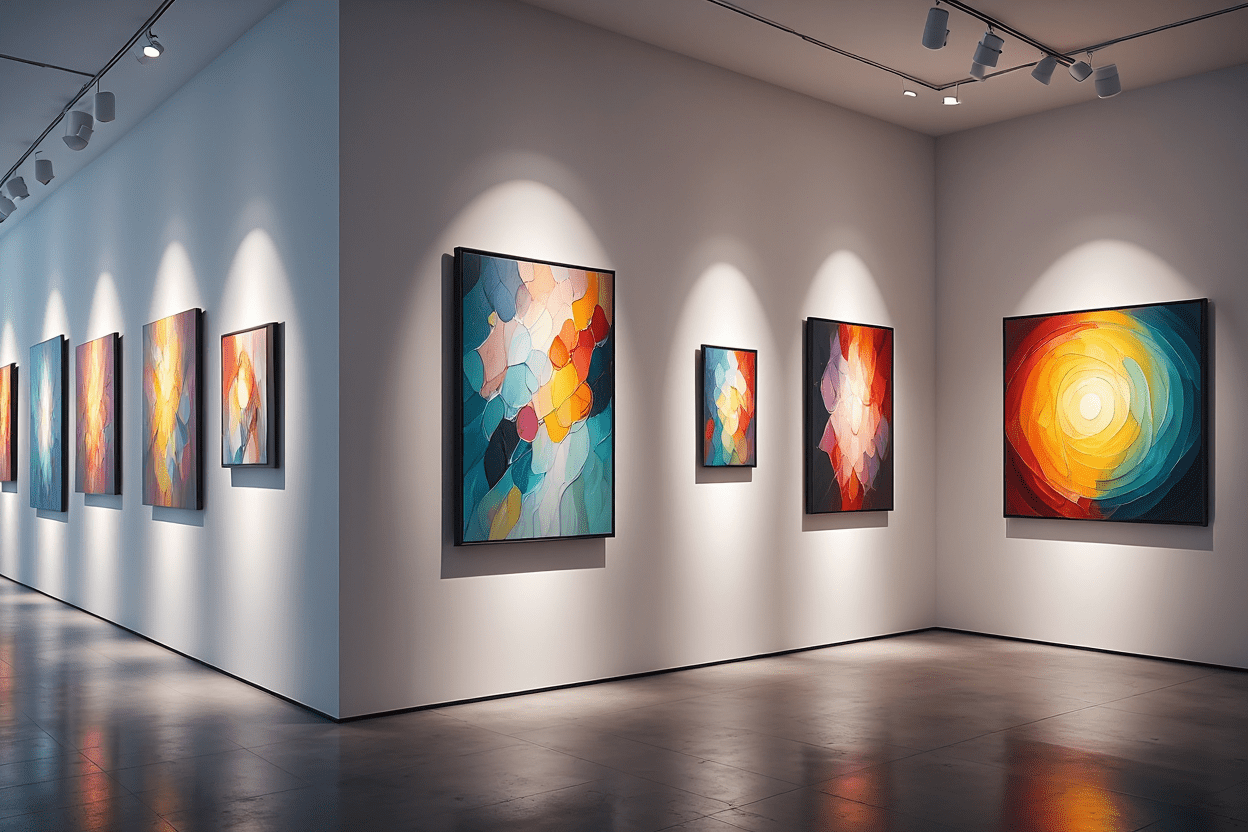
4. Wall Washers
LED wall washers offer smooth and even illumination over the large areas. And you can put them on the walls and ceiling. Therefore, they are the ideal lighting fixtures for art galleries. As they can eliminate harsh glares and shadows, they are perfect for the museum.

5. Spotlights
LED spotlights provide focused illumination that enhances individual artworks, drawing attention to important details. Their adjustability makes them highly versatile, and you can change brightness and direction to suit each piece.
This flexibility helps create mood, depth, and visual interest throughout the gallery. Whether casting a dramatic light on a sculpture or a soft glow over a painting, they help convey the artist’s intent.
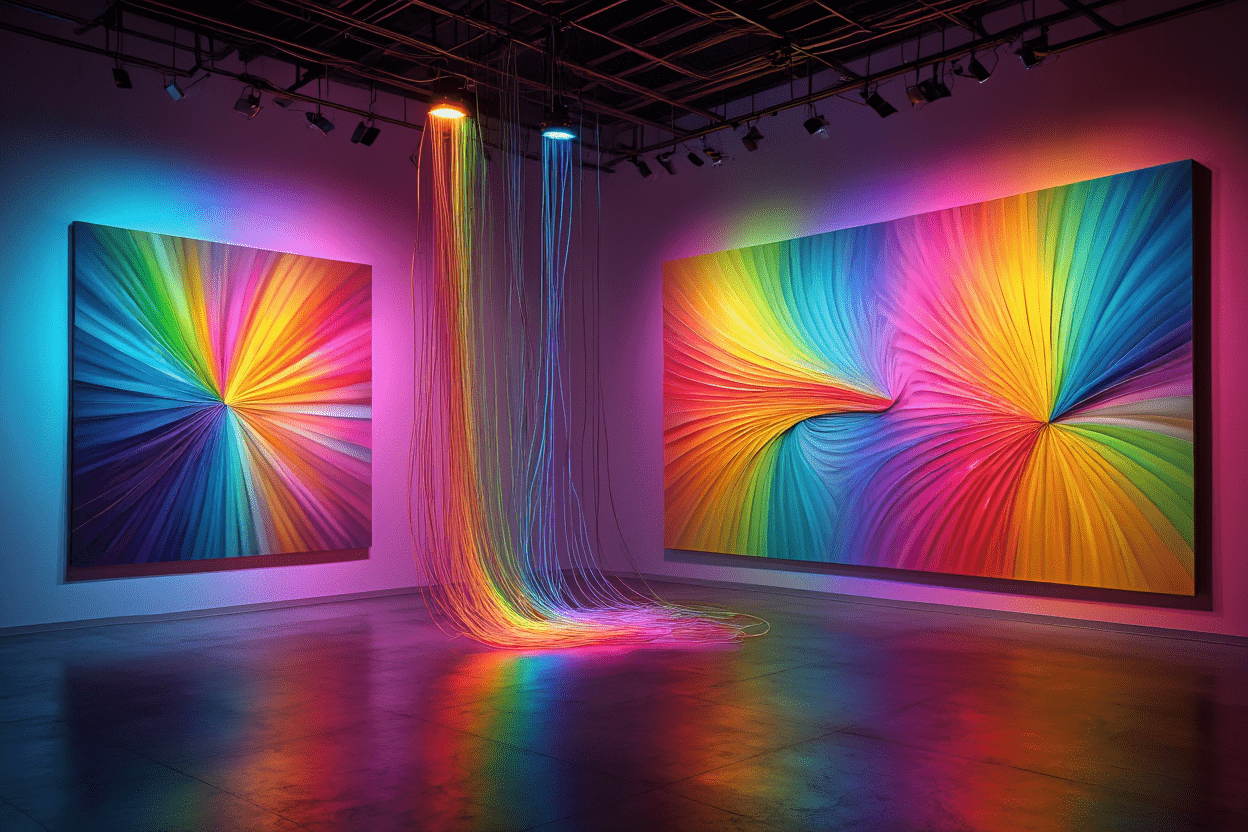
6. Fiber Optic Lighting
Fiber optic lighting uses flexible strands to direct light precisely, which is ideal for showcasing fine details in artwork. This advanced method emits no heat, so they safe for delicate or heat-sensitive pieces. Hence, they can highlight textures and colors without damaging the artwork’s structure.
Besides, the system’s flexibility allows for creative placement and enhances both visibility and aesthetics. By providing clean, focused illumination, fiber optic lighting creates a refined display environment where intricate details are clearly seen and preserved.
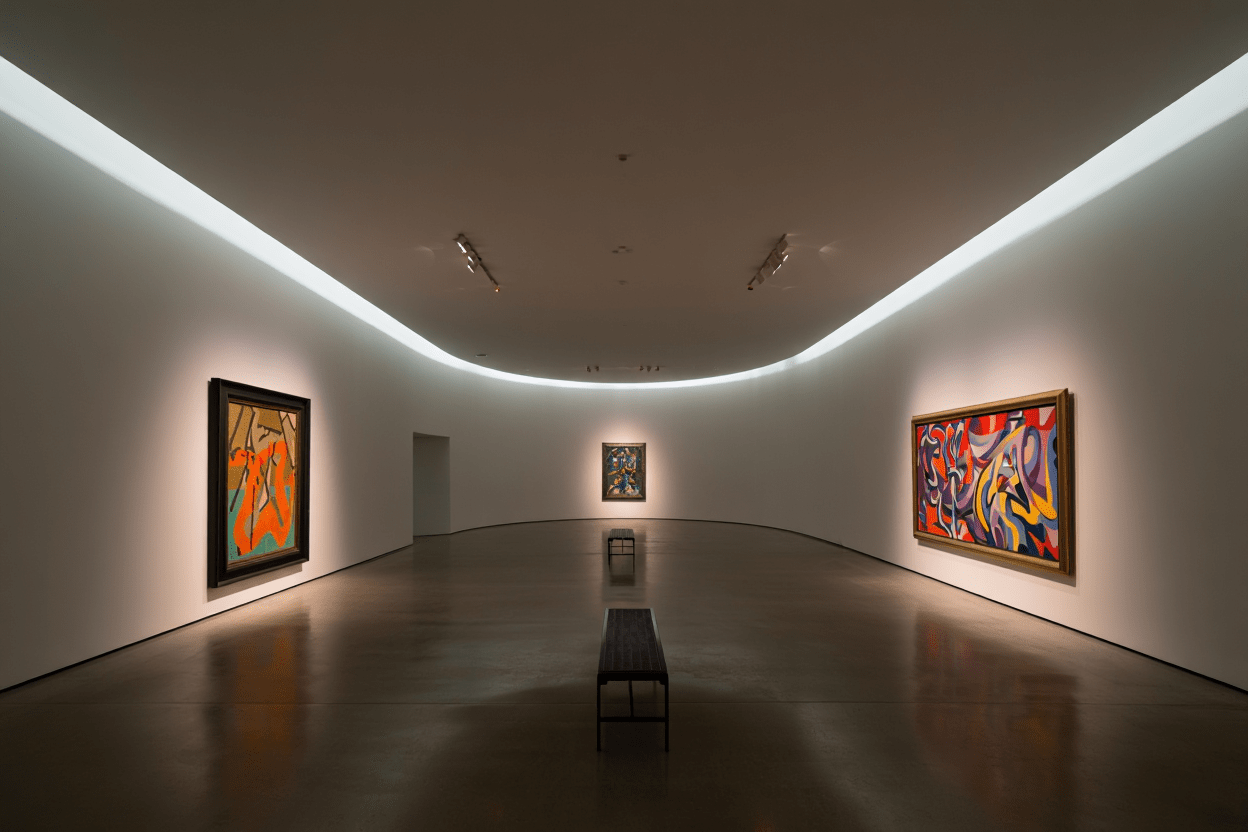
7. Cove Lighting
Typically, cove lights are tucked into ledges or recesses. Therefore, they can offer indirect illumination that gently bathes walls in a soft, ambient glow. This subtle lighting effect elevates the atmosphere and creates a warm and immersive gallery experience. With thoughtful selection and strategic placement, you can craft visually captivating exhibition spaces that highlight artworks.
Lighting Techniques You Can Use In Art Gallery
In an art gallery and museum, you can use different types of lighting techniques. For instance–
Accent Lighting
Accent lighting offers direct focused illumination into certain artworks and highlights individual pieces. Therefore, you can use them for specific artworks, displays, and sculptures to create an engaging atmosphere.
Ambient Lighting
Typically, ambient lighting is the general illumination that generally brightens the gallery and offers a general level of visibility. Therefore, you can use these light fixtures to achieve a balanced brightness throughout the entire space.
This way, they provide even illumination throughout the space, forming a subtle backdrop that enhances other lighting elements. This foundational glow creates a unified, inviting atmosphere.
Task Lighting
Task lights come with adjustable lighting options to illuminate specific areas or objects. This offers ideal visibility for tasks like cataloging, intricate art inspection, and maintenance.
At the same time, they offer focused illumination activities like curating or restoration work. Therefore, they support essential behind-the-scenes tasks that uphold the gallery’s visual appeal and structural upkeep.
Key Considerations When Selecting Art Gallery Lighting Fixtures
You’re now well-versed in the fundamentals of art gallery illumination. Nevertheless, additional factors are needed to achieve flawless lighting for an exhibition. Let’s explore them further.
Choose Suitable Fixtures
Numerous bulbs, such as incandescent and halogen, can be utilized in art galleries, but LEDs, as we previously discussed, are preferable. However, the variety of LED fixtures is vast, with each kind offering a distinct impact and purpose. We touched on a few popular fixtures earlier, but the choices remain. A broad spectrum of alternatives should be examined to identify the ideal one for your gallery.
Moreover, consideration should also be given to the ease of fixture fitting for smooth maintenance. Replacing any faulty fixtures should not consume more than a few minutes, which can be assured by considering the fitting aspect when choosing a lighting solution.
Opt for Adaptable Fixtures
As an art gallery proprietor, your exhibits will span various art forms, from paintings to sculptures, each requiring different lighting conditions. A single-style lighting solution won’t suffice, emphasizing the need for versatility. The market is abundant with flexible LED fixtures, including smart ones that can be remotely adjusted for color, brightness, and even color temperature.
Use a Combination of Fixtures
Monotonous lighting styles can render the gallery dull and uninteresting. This doesn’t imply the need for multicolor lights but rather unique styles for different gallery sections. The assortment of fixtures available can be achieved without resorting to multicolor lights. For instance, a lantern might suit one section, while a spotlight might benefit another.
As discussed above, the goal is to establish a complementary combination that amplifies adaptability.
Grasp the Light Metrics
Each lighting fixture has distinct metrics, such as color temperature, lumen output, and CRI. All three metrics need to be comprehended to find the optimal solution. Lumens measure light brightness – the higher the lumens, the brighter the light.
CRI (Color Rendering Index) is a bit more complex, measuring how closely the light from a fixture replicates natural light on a 0-100 scale. Bulbs with higher CRI values more accurately emulate natural light, making objects underneath appear as they would in sunlight.
However, a high CRI bulb is not always necessary. Certain gallery areas may benefit from lower CRI values. Determining the appropriate CRI for various areas depends on your specific lighting vision.
Similarly, color temperature, measured on the Kelvin scale (ranging from 1,000 to 10,000), is another critical parameter indicating the light’s color emitted by a bulb. Lower-color temperature bulbs emit warm white light, while higher ones produce cool, daylight-like light. Again, determining the suitable color temperature for different areas is essential to your gallery’s overall aesthetic.
Final Thoughts
The importance of lighting in an art gallery is essential. This is not only about illumination, but also about enhancing the viewer’s experience by choosing the proper light fixtures. Thus, planning and implementing the perfect lighting for an art gallery is crucial. And by following this article you can do that easily and conveniently.
However, MyLikeLed is committed to offering top-notch LED strips and LED neon flex products. Our products are rigorously tested in advanced laboratories to meet the highest quality standards. Moreover, we extend customizable solutions for our LED strips and neon flex.
FAQs
Why is lighting important in art galleries?
Lighting is important in art galleries because it helps highlight the artwork’s details, colors, and textures. Good lighting creates the right mood and ensures visitors see the art as the artist intended.
What type of lighting is best for art galleries?
LED lighting is the best choice for art galleries because. It is energy-efficient, produces minimal heat, and offers consistent color rendering, which helps preserve artwork and display it clearly.
How do you prevent artwork from being damaged by lighting?
To prevent damage, use LED lights with low UV and infrared emissions. Avoid direct sunlight and use lighting with controlled brightness and temperature to protect delicate materials in paintings and sculptures.
What is color rendering index (CRI), and why does it matter in galleries?
CRI (Color Rendering Index) measures how accurately a light shows true colors. In galleries, a high CRI (90 or above) is important to make sure the artwork looks as close to natural light as possible.
Should lighting in art galleries be adjustable?
Yes, adjustable lighting is essential in galleries so you can change angles, brightness, or focus based on different exhibitions or display needs. This flexibility improves the viewing experience for each type of art.
Can you use track lighting in art galleries?
Yes, track lighting is a popular option in galleries. It allows easy repositioning of lights and gives curators more control to highlight specific artworks without redoing the whole setup.
How do you light 3D art like sculptures?
To light 3D art, use multiple light sources from different angles. This reduces harsh shadows and shows the depth, texture, and shape of the sculpture clearly.
Are LEDs Safe for Artwork?
Yes, LEDs are safe for artwork. As they convert most of the power into light, which means these fixtures do not heat up as traditional ones. This way, they become safe for any artwork.
Are you considering illuminating your art gallery in the right way and unsure about the lighting fixtures and the process? Therefore, this comprehensive article is for you.
Well, lighting is most important for art galleries and museums to show the paintings, drawings, or any other exhibitions. If you don’t choose the perfect lighting fixtures, it can make the art pieces look dull.
Therefore, I have included here everything you need to know about the lighting in art galleries and museums. Take a look–

What Does Art Gallery Lighting Entail?
Art gallery lighting encompasses various lighting systems and LED fixtures to illuminate and highlight art displays. Aspects such as color temperature, color palette, and color rendering index (CRI) all play pivotal roles in deciding the effectiveness of your gallery’s lighting. To present an art collection flawlessly, the right lighting concepts are just as crucial as the installation techniques that bring them to life.
To understand its significance, let’s look at some key considerations involved in gallery lighting:
- Choosing between optimal and highest CRI.
- Determining the layout of the art display space.
- Analyzing the effects of different lighting systems like adjustable recessed lighting, direct light, museum lighting, and other innovative lighting solutions.
- Assessing the nature of the artwork (quality and type).
- Considering the environment of the artwork room (space type).
These considerations merely scratch the surface of art gallery lighting. A wealth of information must be understood if you’re committed to selecting the ideal lighting fixtures to make your art pieces stand out.
Importance Of Lighting In Art Galleries And Museums

The importance of art lighting serves much more than merely illuminating the space. With the right lighting, you can establish diverse atmospheres, influence visitors’ moods, and elevate the aesthetic appeal of the venue. Various elements, such as color temperature, color rendering index, and the gallery’s dimensions, require careful consideration. Any missteps can drastically alter the gallery’s overall appearance.
Numerous studies have confirmed the relationship between lighting conditions and an art gallery’s success. Each lighting approach distinctly impacts paintings and artworks, shaping visitor perceptions. To understand the power of lighting, observe a painting under the common lights of your home. Then, place the same painting in a well-lit area that accentuates every detail of the artwork, and you’ll appreciate the significance of lighting.
Lighting is a cornerstone for any art gallery, as it adds structure, enhances depth, and brings the gallery’s culture to life. Without suitable lighting, viewers may miss intricate details and potentially misconstrue the message an artwork aims to convey. Quality lighting should enable viewers to distinguish the full spectrum of colors, from the subtlest shades of black and white to the boldest hues.
Moreover, lighting breathes life into artwork, giving it a three-dimensional perspective. You can employ different lighting designs to cast shadows, spotlight various artwork elements, and present the art as you envision it.
Finally, even if not all the artwork in the gallery is yours, you can still infuse your personality into the space. Your gallery can become an artwork through distinct lighting designs, leaving a memorable impression on every visitor.
Types Of LED Lights For Gallery Illumination
Let’s see the common LED lights you can use for an art gallery–

1. Track Lights
Track lights are ideal for those who wish to maintain a clutter-free space. They provide a minimalist design that complements art gallery aesthetics. They also emit a cool color temperature, fostering a warm and inviting atmosphere.

2. Recessed Lights
These lights are another excellent choice for use in art galleries. The recessed lights are fit, neat, and you can hang them on the ceiling. This way, you can make the space look tidier and modern. Besides galleries, they are often used to highlight different types of art. As they are flexible, they can move across and change the angle based on your needs.

3. Surface-Mounted LED Downlights
These versatile LEDs can be affixed to various surfaces, including walls and ceilings. Their key advantage lies in their non-glare nature, validating the investment in an SMD system. And you can position downlights on the walls opposite the artwork; they eliminate the issue of reflections or glare on the displays.

4. Wall Washers
LED wall washers offer smooth and even illumination over the large areas. And you can put them on the walls and ceiling. Therefore, they are the ideal lighting fixtures for art galleries. As they can eliminate harsh glares and shadows, they are perfect for the museum.

5. Spotlights
LED spotlights provide focused illumination that enhances individual artworks, drawing attention to important details. Their adjustability makes them highly versatile, and you can change brightness and direction to suit each piece.
This flexibility helps create mood, depth, and visual interest throughout the gallery. Whether casting a dramatic light on a sculpture or a soft glow over a painting, they help convey the artist’s intent.

6. Fiber Optic Lighting
Fiber optic lighting uses flexible strands to direct light precisely, which is ideal for showcasing fine details in artwork. This advanced method emits no heat, so they safe for delicate or heat-sensitive pieces. Hence, they can highlight textures and colors without damaging the artwork’s structure.
Besides, the system’s flexibility allows for creative placement and enhances both visibility and aesthetics. By providing clean, focused illumination, fiber optic lighting creates a refined display environment where intricate details are clearly seen and preserved.

7. Cove Lighting
Typically, cove lights are tucked into ledges or recesses. Therefore, they can offer indirect illumination that gently bathes walls in a soft, ambient glow. This subtle lighting effect elevates the atmosphere and creates a warm and immersive gallery experience. With thoughtful selection and strategic placement, you can craft visually captivating exhibition spaces that highlight artworks.
Lighting Techniques You Can Use In Art Gallery
In an art gallery and museum, you can use different types of lighting techniques. For instance–
Accent Lighting
Accent lighting offers direct focused illumination into certain artworks and highlights individual pieces. Therefore, you can use them for specific artworks, displays, and sculptures to create an engaging atmosphere.
Ambient Lighting
Typically, ambient lighting is the general illumination that generally brightens the gallery and offers a general level of visibility. Therefore, you can use these light fixtures to achieve a balanced brightness throughout the entire space.
This way, they provide even illumination throughout the space, forming a subtle backdrop that enhances other lighting elements. This foundational glow creates a unified, inviting atmosphere.
Task Lighting
Task lights come with adjustable lighting options to illuminate specific areas or objects. This offers ideal visibility for tasks like cataloging, intricate art inspection, and maintenance.
At the same time, they offer focused illumination activities like curating or restoration work. Therefore, they support essential behind-the-scenes tasks that uphold the gallery’s visual appeal and structural upkeep.
Key Considerations When Selecting Art Gallery Lighting Fixtures
You’re now well-versed in the fundamentals of art gallery illumination. Nevertheless, additional factors are needed to achieve flawless lighting for an exhibition. Let’s explore them further.
Choose Suitable Fixtures
Numerous bulbs, such as incandescent and halogen, can be utilized in art galleries, but LEDs, as we previously discussed, are preferable. However, the variety of LED fixtures is vast, with each kind offering a distinct impact and purpose. We touched on a few popular fixtures earlier, but the choices remain. A broad spectrum of alternatives should be examined to identify the ideal one for your gallery.
Moreover, consideration should also be given to the ease of fixture fitting for smooth maintenance. Replacing any faulty fixtures should not consume more than a few minutes, which can be assured by considering the fitting aspect when choosing a lighting solution.
Opt for Adaptable Fixtures
As an art gallery proprietor, your exhibits will span various art forms, from paintings to sculptures, each requiring different lighting conditions. A single-style lighting solution won’t suffice, emphasizing the need for versatility. The market is abundant with flexible LED fixtures, including smart ones that can be remotely adjusted for color, brightness, and even color temperature.
Use a Combination of Fixtures
Monotonous lighting styles can render the gallery dull and uninteresting. This doesn’t imply the need for multicolor lights but rather unique styles for different gallery sections. The assortment of fixtures available can be achieved without resorting to multicolor lights. For instance, a lantern might suit one section, while a spotlight might benefit another.
As discussed above, the goal is to establish a complementary combination that amplifies adaptability.
Grasp the Light Metrics
Each lighting fixture has distinct metrics, such as color temperature, lumen output, and CRI. All three metrics need to be comprehended to find the optimal solution. Lumens measure light brightness – the higher the lumens, the brighter the light.
CRI (Color Rendering Index) is a bit more complex, measuring how closely the light from a fixture replicates natural light on a 0-100 scale. Bulbs with higher CRI values more accurately emulate natural light, making objects underneath appear as they would in sunlight.
However, a high CRI bulb is not always necessary. Certain gallery areas may benefit from lower CRI values. Determining the appropriate CRI for various areas depends on your specific lighting vision.
Similarly, color temperature, measured on the Kelvin scale (ranging from 1,000 to 10,000), is another critical parameter indicating the light’s color emitted by a bulb. Lower-color temperature bulbs emit warm white light, while higher ones produce cool, daylight-like light. Again, determining the suitable color temperature for different areas is essential to your gallery’s overall aesthetic.
Final Thoughts
The importance of lighting in an art gallery is essential. This is not only about illumination, but also about enhancing the viewer’s experience by choosing the proper light fixtures. Thus, planning and implementing the perfect lighting for an art gallery is crucial. And by following this article you can do that easily and conveniently.
However, MyLikeLed is committed to offering top-notch LED strips and LED neon flex products. Our products are rigorously tested in advanced laboratories to meet the highest quality standards. Moreover, we extend customizable solutions for our LED strips and neon flex.
FAQs
Why is lighting important in art galleries?
Lighting is important in art galleries because it helps highlight the artwork’s details, colors, and textures. Good lighting creates the right mood and ensures visitors see the art as the artist intended.
What type of lighting is best for art galleries?
LED lighting is the best choice for art galleries because. It is energy-efficient, produces minimal heat, and offers consistent color rendering, which helps preserve artwork and display it clearly.
How do you prevent artwork from being damaged by lighting?
To prevent damage, use LED lights with low UV and infrared emissions. Avoid direct sunlight and use lighting with controlled brightness and temperature to protect delicate materials in paintings and sculptures.
What is color rendering index (CRI), and why does it matter in galleries?
CRI (Color Rendering Index) measures how accurately a light shows true colors. In galleries, a high CRI (90 or above) is important to make sure the artwork looks as close to natural light as possible.
Should lighting in art galleries be adjustable?
Yes, adjustable lighting is essential in galleries so you can change angles, brightness, or focus based on different exhibitions or display needs. This flexibility improves the viewing experience for each type of art.
Can you use track lighting in art galleries?
Yes, track lighting is a popular option in galleries. It allows easy repositioning of lights and gives curators more control to highlight specific artworks without redoing the whole setup.
How do you light 3D art like sculptures?
To light 3D art, use multiple light sources from different angles. This reduces harsh shadows and shows the depth, texture, and shape of the sculpture clearly.
Are LEDs Safe for Artwork?
Yes, LEDs are safe for artwork. As they convert most of the power into light, which means these fixtures do not heat up as traditional ones. This way, they become safe for any artwork.

Hi, I’m Xylia Xiong, a sales professional with 14 years of experience in the LED strip light industry. I specialize in providing tailored solutions, leveraging my expertise in LED products and the latest industry trends. Known for effective communication and problem-solving, I’m dedicated to helping lighting manufacturers, importers, and distributors achieve their goals.
Let’s work together to create customized solutions that exceed expectations.
Related Posts
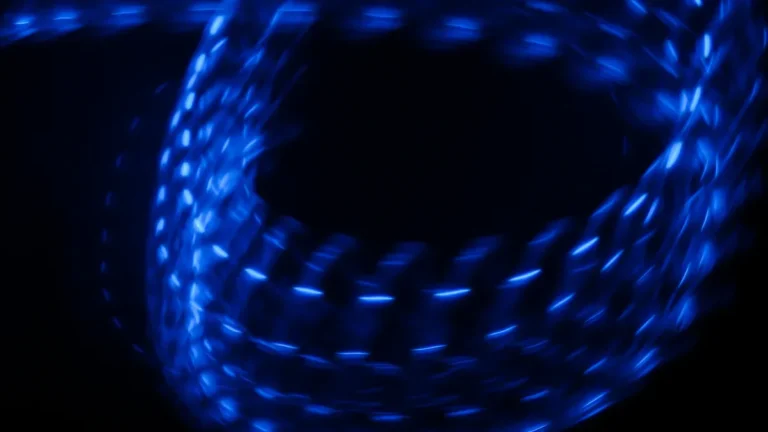
The Best LED Strip Lights You Can Buy Right Now
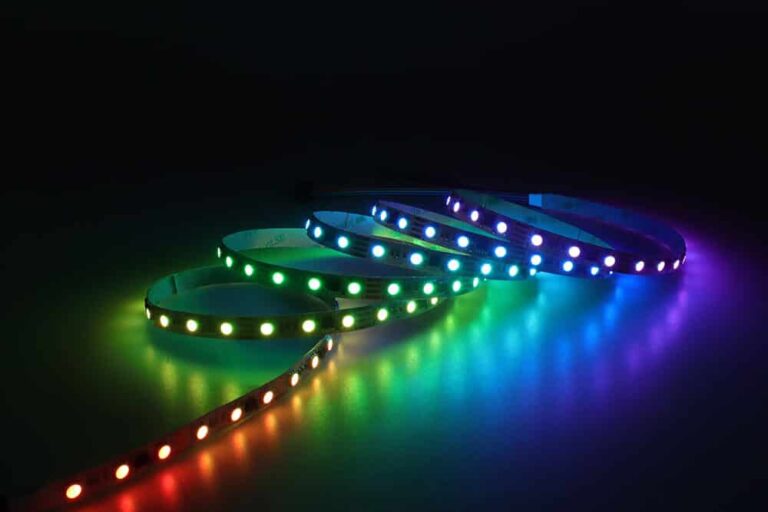
Comparing WS2811 Vs WS2812B: Key Differences


